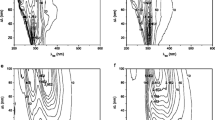The purpose of this paper is to study the feasibility of fluorescence spectroscopy as a reliable method for discrimination of Chinese liquor according to different aroma styles and geographic origins. The 84 Chinese liquors were analyzed by fluorescence spectroscopy and chemometrics. The results showed that Chinese liquors exhibit characteristic fluorescence spectra recorded at special excitation wavelengths that may be considered as fingerprints. Both principal component analysis (PCA) and stepwise linear discriminant analysis (SLDA) were carried out on the emission spectra (330–435 nm) recorded at excitation wavelength 300 nm to classify different aroma styles of Chinese liquors. The first two principal components explained 98.87% of the total variance, and the SLDA classified correctly 100%. Both hierarchical cluster analysis (HCA) and principal component analysis (PCA) were carried out on the emission spectra (325–420 nm) recorded at excitation wavelength 300 nm to identify different geographic origins of Chinese liquors. HCA accurately identified all the samples and the first three PCA explained 98.25% of the total variance. This study indicates that fluorescence spectroscopy coupled with chemometrics offers a promising approach for identifying Chinese liquors according to different flavor types and geographic origins.
Similar content being viewed by others
References
P. Cheng, W. Fan, and Y. Xu, Food Control., 35, 153–159 (2014).
J. J. Li, C. X. Song, C. J. Hou, D. Q. Huo, C. H. Shen, X. G. Luo, M. Yang, and H. B. Fa, J. Agric. Food Chem., 62, 10422–10427 (2014).
M. Liu, X. M. Han, K. Tu, L. Q. Pan, J. Tu, L. Tang, P. Liu, G. Zhan, Q. D. Zhong, and Z. H. Xiong, Food Control, 26, 564–571 (2012).
H. Liang, W. Li, Q. Luo, C. Liu, Z. Wu, and W. Zhang, J. Sci. Food Agric., 95, 2729–2733 (2015).
Z. B. Xiao, D. Yu, Y. W. Niu, F. Chen, S. Q. Song, J. C. Zhu, and G. Y. Zhu, J. Chromatogr. B, 92, 945–951 (2014).
Y. H. Ma, M. P. Li, and S. W. Zhang, Asian J. Chem., 26, 4707–4715 (2014).
J. F. Wu and Y. Xu, Food Sci. Biotechnol., 22, 1253–1261 (2013).
P. Y. Cheng, W. L. Fan, and Y. Xu, Food Res. Int., 54, 1753–1760 (2013).
W. L. Fan and M. C. Qian, J Agric Food Chem., 53, 7931–7938 (2005).
R. Karoui, E. Dufour, J. O. Bosset, and J. De Baerdemaeker, Food Chem., 101, 314–320 (2007).
E. Sikorska, Euro Food Res. Technol., 225, 43–48 (2007).
H. Rouissi, S. Dridi, M. Kammoun, J. De Baerdemaeker, and R. Karoui, Euro Food Res. Technol., 226, 1021–1028 (2008).
M. Hammami, H. Rouissi, N. Salah, H. Selmi, M. Al-Otaibi, C. Blecker, and R. Karoui, Food Chem., 122, 1344–1349 (2010).
A. Sahar, S. Portanguen, A. Kondjoyan, and E. Dufour, Euro Food Res. Technol., 231, 803–810 (2010).
J. Sadecka, J. Tothova, and P. Majek, Food Chem., 117, 491–498 (2009).
E. Dufour, A. Letort, A. Laguet, A. Lebecque, and J. N. Serra, Anal. Chim. Acta, 563, 292–297 (2006).
J. Sadecka and J. Tothova, Euro Food Res. Technol., 230, 797–802 (2010).
J. L. Yang, T. Zhu, Y. Xu, W. L. Fan, G. Q. Chen, and H. Wu, Spectrosc. Spect. Anal., 29, 3339 (2009).
S. D. Rodriguez, M. E. Monge, A. C. Olivieri, R. M. Negri, and D. L. Bernik, Food Res. Int., 43, 797–803 (2010).
D. Granato, G. F. Branco, A. Faria Jde, and A. G. Cruz, J. Sci. Food Agric., 91, 563–569 (2011).
G. L. Feudo, B. Macchione, A. Naccarato, G. Sindona, and A. Tagarelli, Food Res. Int., 44, 781–789 (2011).
R. Zhang, Q. Wu, Y. Xu, and M. C. Qian, J. Food Sci., 79, C1907–1913 (2014).
V. D. Le, X. W. Zheng, J. Y. Chen, and B. Z. Han, J. Instr. Brew., 118, 107–111 (2012).
W. X. Zhang, Z. Y. Wu, Q. S. Zhang, R. Wang, and H. Li, World J. Microbiol. Biotechnol., 25, 172–180 (2009).
J. L. Yang, T. Zhu, Y. Xu, W. L. Fan, and H. Wu, Spectrosc. Spect. Anal., 30, 243–249 (2010).
D. Markechova, P. Majek, and J. Sadecka, Food Chem., 159, 193–198 (2014).
H. Qin, D. Huo, L. Zhang, L. Yang, S. Zhang, M. Yang, C. Shen, and C. Hou, Food Res. Int., 45, 45–51 (2012).
Author information
Authors and Affiliations
Corresponding author
Additional information
Abstract of article is published in Zhurnal Prikladnoi Spektroskopii, Vol. 84, No. 2, p. 338, March–April, 2017.
Rights and permissions
About this article
Cite this article
Ma, Y., Huo, DQ., Qin, H. et al. Classification of Aroma Styles and Geographic Origins of Chinese Liquors Using Chemometrics Based on Fluorescence Spectroscopy. J Appl Spectrosc 84, 361–368 (2017). https://doi.org/10.1007/s10812-017-0477-4
Published:
Issue Date:
DOI: https://doi.org/10.1007/s10812-017-0477-4




